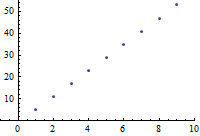
We use MathJax
Informally, a mathematical sequence is a list of numbers. The list could be either finite or infinite. Although the list could certainly be random, the most interesting sequences follow some sort of pattern. For example, consider the sequence:
\begin{equation*} 5, 11, 17, 23, 29, 35, 41, 47, 53, \ldots \end{equation*}This list appears to have a pattern, and the list continues indefinitely.
There are many ways in which a sequence can be described. Considering the same example, we now provide five different descriptions for it.
| List | $5, 11, 17, 23, 29, 35, 41, 47, 53, \ldots$ |
| Verbal Description | Start at $5$. Add $6$ each time. |
| Recursive Formula | $a_n=a_{n-1}+6, \quad a_1=5$ |
| Ordered Pairs | $(1,5),(2,11),(3,17),(4,23),(5,29),\ldots$ |
| Explicit Formula | $a_n = 6n-1$ |
The verbal description describes a pattern that can be observed in the list. The recursive formula is the mathematical equation for the verbal description. Both the verbal description and the recursive formula will uniquely determine the values in the list. However, different people may observe different patterns in a list, and come to different conclusions about the verbal description or the recursive formula used to represent that list.
The list can be written as a sequence of ordered pairs, where the first coordinate denotes the position in the sequence, and the second coordinate is the value of the number at that position. We can then see that a sequence is a set of points that can be graphed, and this suggests that an equation can be written that describes the sequence value as a function of its position in the list. The explicit formula is that function.

Having considered various descriptions of a sequence, we are now ready to provide some official definitions.
The natural numbers are the counting numbers, namely 1, 2, 3, 4, and so on. In other words, a sequence has a restricted domain. The list begins with a first term, is followed by a second term, and a third term, and so on. It is not possible to have a term in a fractional position, or in a negative position. (Sometimes, people will introduce other positions, and it is rather common to see some sequences defined to have a zeroth position. Nevertheless, the idea of a restricted domain is still present, and is a hallmark of a sequence.)
Since a sequence is a function, we might expect to see function notation, such as $f(x)=6x-1$ for the example above. However, it is common practice to use sequence notation instead, thus writing the example above as $a_n=6n-1$. Instead of using $x$ as the independent variable, the values of the domain are represented by $n$, which is often used by mathematicians to denote variables restricted to the natural numbers. The sequence value is denoted by $a_n$, which can typically be interpreted as the current term of the sequence (that is, the term in the current position). Similarly, $a_{n-1}$ is often interpreted as the previous term of the sequence, and $a_{n+1}$ is the next term of the sequence.
Two different types of formulas are commonly used to describe sequences. The recursive formula describes each term of the sequence in relation to the terms immediately preceding it. Therefore, if we stumble upon 521 in the sequence, and the recursive formula tells us that $a_n = a_{n-1}+6$, then we know the next term is 527. It is not necessary to know the position in the list to obtain the next value. But if we didn't have the list of values yet, and we wanted to find the one-hundredth term, we would have to begin by finding the first 99 terms.
On the other hand, the explicit formula does depend on the position of the list. If we want to find the one-hundredth term, the explicit formula makes it very easy, $a_{100}=6(100)-1=599$. It is not necessary to know the previous term in the list. But if we had the previous term of the list and did not know its position, we would have to first use the formula to determine that position before we could find the next term. In other words, recursive formulas and explicit formulas serve two very different purposes.
Most problems involving sequences involve one or more of the following types: